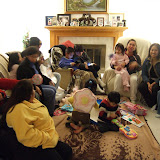
Did you ever need a progress GUI injected in your program? I did, and I still do. A progress GUI is something that is nice to have to show how a long running program is progressing. You don't want a user to think that your program is stuck. Last thing you want to happen is the user doing Ctrl+Alt+Delete then End Task. And so my solution is to display something like this:
Here's how my module is used:
use SamTools::ProgressGUI;
my $GUI = SamTools::ProgressGUI->new({
Title => 'Organization Name - Install Status',
ProgressBar => 1,
});
$GUI->show("Installing Software...");
foreach (1..10) {
$GUI->step();
sleep 1;
}
$GUI->hide();
Here's the module. I will probably contribute this to CPAN, just need to find time to prepare it, but here you go, enjoy...
#!/usr/bin/perl -w
#
# This is module for displaying progress GUI
# Written By: Sam Dela Cruz
# Date : 05/18/2006
# Version : 1.00
#
package SamTools::ProgressGUI;
use strict;
use Win32::GUI;
use Win32::GUI::BitmapInline;
# Constructor
sub new {
my $proto = shift;
my $class = ref($proto) || $proto;
my $self = {};
bless($self, $class);
#initialize object
return $self->_init(@_);
}
# Initialize object
sub _init {
my $self = shift;
# default values
$self->{'title'} = 'Install Progress';
$self->{'progressbar'} = 0;
# Have we been passed anything
if (@_ != 0){
# We are expecting our configuration to come as an anonymous hash
if (ref $_[0] eq 'HASH'){
my $hash=$_[0];
foreach my $key (keys %$hash){
$self->{lc($key)}=$hash->{$key};
}
}
else {
( $self->{'title'}, $self->{'progressbar'} ) = @_;
}
}
#create the GUI
return $self->_createGUI;
}
# Create the GUI
sub _createGUI {
my $self = shift;
# Program Icon
$self->{'icon'} = newIcon Win32::GUI::BitmapInline( q(
AAABAAEAICAAAAAAAACoCAAAFgAAACgAAAAgAAAAQAAAAAEACAAAAAAAgAQAAAAAAAAAAAAAAAEA
AAAAAAAAAAAAAACAAACAAAAAgIAAgAAAAIAAgACAgAAAwMDAAMDcwADwyqYA8PDwAJn//wCZ1JkA
/9SZAP/M/wCZmf8AMCIiABEAAAAiAAAARAAAAFUAAAB3AAAAiAAAAKoAAADdAAAA7gAAAAARAAAA
IgAAAEQAAABVAAAAdwAAAIgAAACqAAAA3QAAAO4AAAAAEQAAACIAAABEAAAAVQAAAHcAAACQAAAA
qgAAAN0AAADuADMAAABmAAAAmQAAAMwAAAAAMwAAMzMAAGYzAAChMwAAzDMAAP8zAAAAZgAAM2YA
AGZmAACZZgAAzGYAAP9mAAAAmQAAM5kAAGaZAACZmQAAzJkAAP+ZAAAAzAAAM8wAAGbMAACZzAAA
zMwAAP/MAAAz/wAAZv8AAJn/AADM/wAAAAAzADMAMwBmADMAmQAzAMwAMwD/ADMAADMzADszMwBm
MzMAmTMzAMwzMwD/MzMAAGYzADNuMwBmZjMAmWYzAMxmMwD/ZjMAAJkzADOZMwBmmTMAmZkzAMyZ
MwD/mTMAAMwzADPMMwBmzDMAmcwzAMzMMwD/zDMAAP8zADP/MwBm/zMAmf8zAMz/MwD//zMAAABm
ADMAZgBmAGYAmQBmAMwAZgD/AGYAADNmADMzZgBmM2YAmTNmAMwzZgD/M2YAAGZmADNmZgBmZmYA
mWZmAMxmZgD/ZmYAAJlmADOZZgBmmWYAmZlmAMyZZgD/mWYAAMxmADPMZgBmzGYAmcxmAMzMZgD/
zGYAAP9mADP/ZgBm/2YAmf9mAMz/ZgD//2YAAACZADMAmQBmAJkAmQCZAMwAmQD/AJkAADOZADMz
mQBmM5kAmTOZAMwzmQD/M5kAAGahADNmmQBmZpkAmWaZAMxmmQD/ZpkAAJmZADOZmQBmmZkAmZmZ
AMyZmQD/mZkAAMyZADPMmQBmzJkAmcyZAMzMmQD/zJkAAP+ZADP/mQBm/5kAmf+ZAMz/mQD//5kA
AADMADMAzABmAMwAmQDMAMwAzAD/CNQAADPMADMzzABmM8wAmTPMAMwzzAD/M8wAAGbMADNmzABm
ZswAmWbMAMxmzAD/ZswAAJnMADOZzABmmcwAmZnMAMyZzAD/mcwAAMzMADPMzABmzMwAmczMAMzM
zAD/zMwAAP/MADP/zABm/8wAmf/MAMz/zAD//8wAMwD/AGYA/wCZAP8AzAD/AAAz/wAzM/8AZjP/
AJkz/wDMM/8A/zP/AABm/wAzZv8AZmb/AJlm/wDMZv8A/2b/AACZ/wDd3d0AzJn/AGbM/wAAAIgA
/wDMAJkzAAAzZjMAAGaZADMzMwDw+/8ApKCgAICAgAAAAP8AAP8AAAD//wD/AAAA/wD/AP//AAD/
//8A//////////8KgVdXXVdXXXtXXXtXXXsJ///////////////2//b/9lcZ/Bn8GRkZGRkZGRkZ
GVHV9v/29v/2//v7+/v7+/v7+/v7+/v7+/v7+/v7+/v7+/v7+/v7+/v7+/v7+/v7+/v7+/v7+/v7
+/v7+/v7+/v7+/v7+/v7+/v7+/v7+/v7+/v7+/v7+/v7+/v7+/v7+/v7+/v7+/v7++0LCu2AXFZW
elZWelZWVlZWVlZWVVZWVlZWVlYHCwoL///VGRn8/Pz8/Pz8/Pz8/Pz8/Pz8/Pz8/Pz8/Pyr///2
1Rn8/Pz8/Pz8Gfz8Gfz8Gfz8/Pz8/Pz8/Pz8/Pyr/85zUPz8/PwFUBkZ/HvOD8/VD87IGfz8UAUF
BQVQGfyrK/m5/Pz8T/mWGRmBD/n5D//5+fnP/AX5+fn5+fm5UPzc+fn8/Py6+fkZgf/h+fkK9vn5
+f/Pc/n5K9zc+fkqGZX5+VD8Gfn5+Z3//+H5+f//+fn5//8OuXMZGRm6+flzBfn5c/xz+fn54Qr/
+fnh///5+fn///8OGRkZ/HT5+bpQ+fkFGbn5+fn5Cg/5+ej///n5+f////97Gfz8lvn5BRj5+bkY
+fm5+fkPD/n5D///+fn5/////3sZ/AUr+flQ/Nz5+QX5+VDc+dzo+fkKCv/5+fn///8Ke1AqK/n5
lvz8lfn5+fkq/Mb5+Ssr+f////n5+f///wrd+fn5KwX8/PwF+fn5+QX8zvkrKyvi////+fkr//8K
4fn5+blRGfz8/FD5+fn5UPzVKysrK+j///8rKyv//w/5+flP/Pz8/Pz8Gfn5+Sv8/IHoKyv5D///
/ysrK///6Pn5Bfz8/Pz8/Pz83Pn5lvz8/J0rK/kK////Kysr///i+fl0/Pz8GRn8/PyW+flz/Pz8
/Csr3P////8rKyv/q3P5+blzUJcqc/wZGQUr3Pz8/Pz8livh/wr///n5K8/8/Lr5+fn5+fm5/NUZ
dCuW/Pz8/PxzK8HVCc/V3PkrGfz8GZcrK/kr3HOr/9UZGfz8/Pz8/Pz8/Pz8/Pz8/Pz8/Pz8/PwZ
Ufz8q////9X8/Pz8/Pz8/Pz8/Pz8/Pz8/Pz8/Pz8/Pz8GQn//////wpX/Pz8GRkZGRkZGRkZGRkZ
GRkZGRkZGfyr////a2trkGtIRENIQ0NJQ0NJQ0NJQ0NJQ0NJQ0NJa2uQa2v6+vr6IiIiIiIiIiIi
IiIiIiIiIiIiIiIiIiIiIiIiIvr6IiIiIiIiIiIiIiIiIiIiIiIiIiIiIiIiIiIiIiIia2tra2tr
a2tEQ0NDQ0NDQ0NDQ0NDQ0NDa2tra2tra2v//////////wpXV1dXV1dXV1dXV1dXV9X/////////
/wAAAAAAAAAAAAAAAAAAAAAAAAAAAAAAAAAAAAAAAAAAAAAAAAAAAAAAAAAAAAAAAAAAAAAAAAAA
AAAAAAAAAAAAAAAAAAAAAAAAAAAAAAAAAAAAAAAAAAAAAAAAAAAAAAAAAAAAAAAAAAAAAAAAAAAA
AAAAAAAAAAAAAAAAAAAA
) );
# Start Pop-Up Window GUI
$self->{'screen_width'} = Win32::GUI::GetSystemMetrics(0);
$self->{'screen_height'} = Win32::GUI::GetSystemMetrics(1);
$self->{'font1'} = new GUI::Font(-name=>"Tahoma",
-height=>8,
);
$self->{'font2'} = new GUI::Font(-name=>"Tahoma",
-height=>14,
-bold=>1,
);
$self->{'font3'} = new GUI::Font(-name=>"Tahoma",
-height=>9,
-bold=>1,
);
$self->{'font4'} = new GUI::Font(-name=>"Tahoma",
-height=>11,
-bold=>1,
);
$self->{'Popup'} = new GUI::DialogBox(
-name => "Popup",
-text => $self->{'title'},
-size => [400, 150],
-pos => [(($self->{'screen_width'}/2)-200),
(($self->{'screen_height'}/2)-125)],
-font => $self->{'font1'},
-helpbutton => 0,
);
my $wc = $self->{'Popup'}->Width();
$self->{'Popup'}->SetIcon($self->{'icon'});
$self->{'Popup'}->AddLabel( -name => "PopupLabel",
-text => "",
-top => 20,
-left => 20,
-height => 80,
-width => $wc-40,
-font => $self->{'font1'},
);
#display progress bar if specified in object creation
if ($self->{'progressbar'}) {
$self->{'Popup'}->AddProgressBar( -name => "ProgressBar",
-width => $wc-40,
-height => 10,
-top => 80,
-left => 20,
-smooth => 1,
);
$self->{'Popup'}->ProgressBar->SetPos (0);
$self->{'Popup'}->ProgressBar->SetRange(0,50);
$self->{'Popup'}->ProgressBar->SetStep (1);
}
$self->{'Popup'}->SetForegroundWindow();
return $self;
}
# Methods
sub show {
my $self = shift;
my $message = shift;
$self->{'Popup'}->PopupLabel->Text($message);
$self->{'Popup'}->Show();
Win32::GUI::DoEvents();
}
sub step {
my $self = shift;
$self->{'Popup'}->ProgressBar->StepIt() if ($self->{'progressbar'});
Win32::GUI::DoEvents();
}
sub hide {
my $self = shift;
if ($self->{'progressbar'}){
$self->{'Popup'}->ProgressBar->SetPos(50);
sleep 1; # give chance to show completion of progress bar
}
$self->{'Popup'}->Hide();
Win32::GUI::DoEvents();
}
1;
__END__
=head1 NAME
SamTools::ProgressGUI - Sam's Simple Progress GUI
=head1 SYNOPSIS
use SamTools::ProgressGUI;
# Pretty format, all the parameters
my $GUI = SamTools::ProgressGUI->new({
Title => 'Organization Name - Install Status', # define the window title
ProgressBar => 1, # display progress bar
});
# Typical usage
my $GUI = SamTools::ProgressGUI->new({
Title => 'Organization Name - Install Status',
ProgressBar => 1,
});
# Display status window with the message
$GUI->show("Installing Software...");
# Move the progress bar
$GUI->step();
# Hide the status GUI
$GUI->hide();
=head1 DESCRIPTION
I is a class providing methods to display a progress GUI. There are a number
of parameters that can be passed to allow configuration of the GUI.
=head1 REQUIRED MODULES
Win32::GUI;
Win32::GUI::BitmapInline;
=head1 METHODS
There are no class methods, the object methods are described below.
Private class method start with the underscore character '_' and
should be treated as I.
=head2 new
Called to create a I object. The following optional named parameters can be
passed to the constructor via an anonymous hash:
=over 4
=item Title
Defines the window title. If not defined in the
constructor then it will use the default "Philips NA IT - Install Progress".
=item ProgressBar
Used to determine if a progress bar is needed.
Default is none.
=back
=head2 _init & Private methods
I method to initialise the object on construction. Called by C.
All I methods start with B<_> and should be treated as PRIVATE. No other
private methods are documented (since they are private).
=head2 show
The C method is used to show the Progress GUI with message specified.
eg. $GUI->show("Installing Software...");
=head2 step
C is used to step the progress bar if progress bar is turned on.
=head2 hide
C is used to hide the GUI.
=head1 KNOWN ISSUES
none
=head1 AUTHOR
Sam Dela Cruz, sammydc at gmail dot com
=head1 LICENSE
Copyright (c) 2006 - Sam Dela Cruz. All rights reserved. This
program is free software; you can redistribute it and/or modify it under
the same terms as Perl itself.
=cut
This is in preparation for a project that I'm involved in. The project is to build a global reporting solution for IT using SQL Server 2005 Reporting Services. Here are some key words I want to remember about data warehousing:


